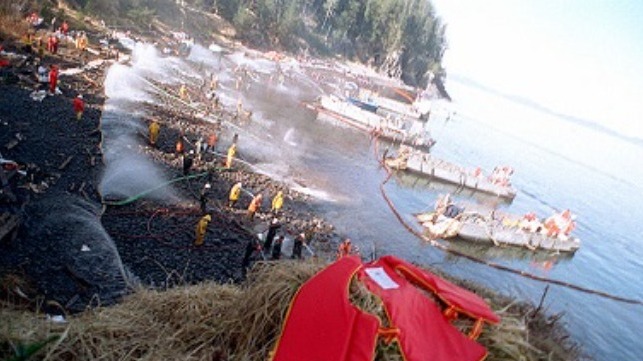Preventing the Next Exxon Valdez

There is a sad irony when you consider that the laws and regulations necessitated by the Exxon Valdez oil spill to protect the marine environment are not designed to accommodate the conditions that exist in Western Alaska and the Arctic today.
Alaska’s coastline and environment were forever changed when the tanker Exxon Valdez ran aground on Bligh Reef on March 24, 1989 – and the impacts of that spill reverberate today. It was in the aftermath of the spill that Congress enacted the Oil Pollution Act of 1990, or OPA 90, requiring ship operators to implement comprehensive systems to respond to an oil spill. Much like the system for tankers in Prince William Sound, the new regulations required the worst-case oil spill from any tank vessel to be covered with resources contracted from the private sector. However, the regime developed under this seminal law simply does not adapt to the challenging conditions that exist in Western Alaska and the U.S. Arctic. The vast distances and enormous time involved to respond to a spill are not reflected in the regulations, which were largely developed in consideration of the type of incident that could occur in the contiguous U.S.
Following other high profile ship casualties and oil spills – like the Cosco Busan in San Francisco Bay and the Selendang Ayu west of Dutch Harbor, Alaska – attention turned to the immense number of vessels transiting Alaskan waters which were not incorporated in OPA 90. Congress worked to resolve this problem by including vessels that do not carry oil as cargo (“nontank vessels”) in the OPA 90 regime. This Congressional “fix” worked well in ports located in the Lower 48 but fell short in Alaska. Many ports in the Lower 48 already had existing response systems developed by oil spill cooperatives, making compliance with these changes to OPA 90 relatively easy to achieve. But the same type of infrastructure simply does not exist along the vast majority of Alaska’s expansive, remote, and rugged coastline.
Alaska operators, principally the barge operators who deliver refined oil products that fuel Western Alaska’s economy and sustain our communities, came up with effective alternatives to meet compliance objectives. These alternatives would preserve safety, while accounting for the uniqueness of the Last Frontier. The creation of the nonprofit, industry-funded response organization Alaska Chadux Corporation in 1993 was an integral part of their compliance solution (now called Alaska Chadux Network).
In this new era for OPA 90 compliance and its application to the nontank vessel fleet in Western Alaska and the Arctic, the Alaska Chadux Network stood up to meet the challenges confronting the maritime industry and expectations of the communities of Western Alaska and agencies. The result was a comprehensive prevention and response program developed by Alaskans with decades of response experience in Western Alaska.
Using the Juneau-based Marine Exchange of Alaska, our program now takes preventive measures to track each vessel in Western Alaska and the Arctic, monitoring its operating status and providing early warning if assistance is needed. Despite these initiatives, marine casualties can still occur, and for that reason the Alaska Chadux Network also developed 17 response hubs throughout Western Alaska and Prince William Sound. This includes the only two fully dedicated offshore, oil spill response vessels in Western Alaska stationed in Kodiak and Dutch Harbor.
Alaska Chadux Network’s approach of “prevention focused and response ready” is easily said but not always easy to execute – particularly as ships grow larger, the U.S. Arctic opens, and climate changes impact the communities throughout Alaska. OPA 90 never envisioned a comprehensive oil spill response system in these remote stretches of Western Alaska and the U.S. Arctic, however, such a system is becoming more necessary with time.
Alaska’s communities and businesses will feel the brunt of a major marine casualty in Western Alaska and the Arctic just like so many communities did 32 years ago along the coast of southcentral Alaska. Instead of waiting for the next Exxon Valdez to spur us to action, now is the time to develop solutions which ensure the residents and communities of Western Alaska enjoy protections to the pristine waters that surround them. We at the Alaska Chadux Network are ready to contribute our 28 years of working throughout Western Alaska as we debate and address these critical issues. Let us not wait for another oil spill disaster to initiate action to change the law to address this circumstance because, just like winter in Alaska, we know that day could soon come.
Buddy Custard is the President and Chief Executive Officer of the Alaska Chadux Network. He served with the U.S. Coast Guard for over 30 years, attaining the rank of captain, and he served as a senior manager for an oil exploration and production company operating in the U.S. Arctic Outer Continental Shelf.
The opinions expressed herein are the author's and not necessarily those of The Maritime Executive.
